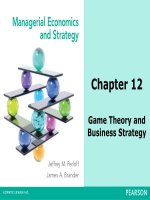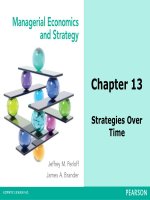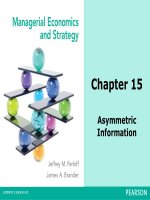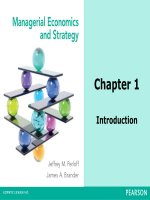Ecomomics evelopment 10th by p todaro and smith chapter 14
Bạn đang xem bản rút gọn của tài liệu. Xem và tải ngay bản đầy đủ của tài liệu tại đây (767.19 KB, 34 trang )
Chapter 14
Foreign Finance,
Investment, and
Aid: Controversies
and Opportunities
Copyright © 2009 Pearson Addison-Wesley. All rights reserved.
Multinational Corporations (MNCs)
•
Corporations that conduct and control productive activities in more than one
country
•
Large firms mostly from the U.S., Europe, and Japan
•
350 MNCs control 40% of international trade in primary and secondary products
Copyright © 2009 Pearson AddisonWesley. All rights reserved.
14-2
Copyright © 2009 Pearson AddisonWesley. All rights reserved.
14-3
Foreign Direct Investment (FDI)
•
FDI is investment by MNCs
•
FDI in LDCs rose from an annual rate of $11 billion in 1980 to $1,100 billion in
2000, but fell to $600 in 2005
•
Major recipients of FDI are China, Brazil, Argentina, and Mexico
Copyright © 2009 Pearson AddisonWesley. All rights reserved.
14-4
FDI Inflows, 1980–2005
Copyright © 2009 Pearson AddisonWesley. All rights reserved.
14-5
FDI Inflows to LDCs in Relation to
Domestic Investment,1990–2003
Copyright © 2009 Pearson AddisonWesley. All rights reserved.
14-6
Copyright © 2009 Pearson AddisonWesley. All rights reserved.
14-7
FDI Debate: Pros
FDI fills the
•
Saving gap: causing economic growth
•
Foreign-exchange gap: improving the BOP
•
Tax revenue gap: raising funds for public spending
•
Management gap: improving entrepreneurship
•
Technology gap: facilitating industrialization
Copyright © 2009 Pearson AddisonWesley. All rights reserved.
14-8
FDI Debate: Cons
MNCs
•
Don’t reinvest their profit
•
Return profits to their headquarters through transfer pricing
•
Create income for semi-skilled labor with low saving propensities
•
Deteriorate current account through importation of capital goods and intermediate
products
Copyright © 2009 Pearson AddisonWesley. All rights reserved.
14-9
FDI Debate: Cons
MNCs
• Deteriorate capital account through outflow of profits
• Receive investment tax credits and are exempt from
tariffs
• Hinder development of domestic managerial skills
• Gain monopoly power
• Reinforce dualism, increase income inequality, and
induce R-U migration
• Influence local politics and support “friendly”
Copyright
© 2009 Pearson Addisongovernments
Wesley. All rights reserved.
14-10
Seven Key Disputed Issues about the Role
and Impact of MNCs in LDCs
Copyright © 2009 Pearson AddisonWesley. All rights reserved.
14-11
Seven Key Disputed Issues about the Role
and Impact of MNCs in LDCs
Copyright © 2009 Pearson AddisonWesley. All rights reserved.
14-12
FDI Debate: Pros & Cons
Yes, MNCs
–
Create jobs and income
–
Transfer managerial skills and technology
But, MNCs
–
Invest in most profitable business venture
–
Transfer their profits out
Copyright © 2009 Pearson AddisonWesley. All rights reserved.
14-13
Private Portfolio Investment
•
Foreign investment in the LDCs’ financial markets: i.e., stocks, bonds, certificates
of deposit, commercial papers
•
Investment in bonds and CDs increased from $4 billion in 1989 to $54 billion in
1997
•
Investment is stocks rose from $2.2 billion in 1989 to $33 billion in 1997
Copyright © 2009 Pearson AddisonWesley. All rights reserved.
14-14
Private Portfolio Investment
The “emerging-country” financial markets of the NICs offered
•
High rates of return (e.g., 39% in Latin American stock markets in 1988-93)
•
High risks due to frequent volatility
• Mexican currency crisis in 1994-95
• Asian financial crisis: a net outflow of $12 billion
in 1997 in contrast to a net capital inflow of $93
billion in 1996
Copyright © 2009 Pearson AddisonWesley. All rights reserved.
14-15
Copyright © 2009 Pearson AddisonWesley. All rights reserved.
14-16
The Role and Growth of Remittances
•
Wages and salaries made in a host country, but sent back to the home country
•
Wage differences
•
“Brain Drain”
•
Uneven flow of remittances
Copyright © 2009 Pearson AddisonWesley. All rights reserved.
14-17
Resource Flows to Developing
Countries, 1990–2005
Copyright © 2009 Pearson AddisonWesley. All rights reserved.
14-18
Top 20 Remittance Recipient Countries,
2004
Copyright © 2009 Pearson AddisonWesley. All rights reserved.
14-19
Foreign Aid
All governmental resource transfers from one
country to another
•
Expressed in real terms
•
Exclude military aid
•
Exclude transfers from private foreign investors
•
Must be allocated to economic development projects and programs
Copyright © 2009 Pearson AddisonWesley. All rights reserved.
14-20
Kinds of Foreign Aid
•
Official Development Assistance: grants and loans
•
Tide aid: the donor requires the recipient to use the funds to import products from
companies in the donor country
•
Untied aid: the donor provides assistance for developmental projects and plans
Copyright © 2009 Pearson AddisonWesley. All rights reserved.
14-21
Donation of Foreign Aid
• In monetary value, the U.S. and Japan are the
largest donor
• In percentage of GDP, Sweden and Netherlands
are the largest donor
• In monetary value, FA increased from 1985 to
2005
• In percentage of GDP, FA fell from 0.35 in 1985 to
Copyright
2009 Pearson
Addison0.23 in©2002,
but rose
to 0.33 in 2005
Wesley. All rights reserved.
14-22
Table 14.2 Official Development Assistance
Disbursements from Major Donor Countries,
1985, 2002, and 2005
Copyright © 2009 Pearson AddisonWesley. All rights reserved.
14-23
Allocation of Foreign Aid
•
In U.S. $ per capita, the largest recipients are countries in the Middle East
& North Africa and Sub-Saharan Africa
•
In percentage of GNI, the largest recipients are countries in Sub-Saharan
Africa and the Middle East & North Africa and
Copyright © 2009 Pearson AddisonWesley. All rights reserved.
14-24
Table 14.3 Official Development
Assistance (ODA) by Region,
2005
Copyright © 2009 Pearson AddisonWesley. All rights reserved.
14-25









